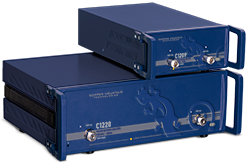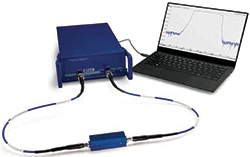
To resolve product performance issues related to operation in crowded, interference-filled low frequency bands, the global electronics industry is designing and building an increasing number of devices that utilize higher frequencies. A typical example is Wi-Fi, transitioning from 2.4 to 5 GHz channels. Device providers also face booming worldwide demand for wireless technology components.
In all cases, device manufacturers test their products and components with vector network analyzers (VNA). These manufacturers need VNAs that can handle advanced test applications and provide fast measurements to expedite production processes. To fulfill this demand, Copper Mountain Technologies recently introduced its Cobalt series of VNAs. The initial C1220 and C1209 models offer S-parameter measurement between 100 kHz and 20 GHz.
With a frequency range of 100 kHz to 20 GHz, the C1220 VNA represents the industry’s first USB-based, modular, laboratory grade, 20 GHz VNA. The analyzer offers a typical dynamic range of 145 dB, an output power range of -60 to +10 dBm, up to 500,001 measurement points per sweep and a measurement speed up to 10 microseconds per point. The size of the C1220 is 14.8" × 16.3" × 5.5" (376 × 415 × 140 mm). Typical applications for the C1220 include signal integrity measurements for high speed digital systems, where 18 to 20 GHz is needed to accommodate system operating frequencies. As new technologies enable lower power operation at higher frequencies, other devices will operate in the range of 14 to 18 GHz, so component vendors have to test there as well.
The C1209 VNA is capable of analyzing from 100 kHz to 9 GHz and incorporates many of the same technical specifications as the C1220 in a compact half-rack size (14.8" × 8.3" × 3.7" or 377 × 210 × 95 mm) that weighs 4.8 kg.

Figure 1 The VNA transfers measurement data to a PC, via USB, for processing.
AllCopper Mountain VNAs have separate measurement and processing modules and offload the processing of measurement results to an external PC, via USB (see Figure 1). The design provides improved processing power and better display and data management, paired with extremely reliable performance.
The performance of the Cobalt instruments benefits from several new design, manufacturing and test approaches. Innovative test-grade coaxial connector technology for internal interconnects and tighter tolerances enhance measurement accuracy. Advanced electromagnetic modeling optimizes the 20 GHz Cobalt’s ultra-wideband directional coupler design, providing excellent stability with varying temperature and long time intervals. The analyzers’ hybrid dual-core DSP+FPGA signal processing engine combined with new frequency synthesizer technologies enable measurement speeds comparable to the most advanced instruments in the industry.
To facilitate high speed measurements, the C1220 and C1209 analyzers have new, wider IF bandwidth options and advanced input/output triggering. A greater IF bandwidth shortens the measurement sweep time and can eliminate production line bottlenecks. The analyzers’ advanced trigger output also speeds production by enabling the measuring process to be synchronized with robotic automation systems.
Semiconductor testing is a key application for the analyzers, where measurement speed is a critical issue. The wireless industry produces around 2 billion cellular handsets every year, and every handset contains numerous semiconductor chips – many of which require a VNA manufacturing test. The measurement speed of the analyzers translates directly to the overall throughput of the chip-producing facility.
The compact size and operational flexibility of the Cobalt analyzers also contribute to efficient use of space on the manufacturing floor.
Copper Mountain Technologies
Indianapolis, Ind.
www.coppermountaintech.com
